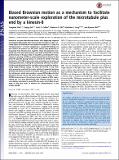| dc.contributor.author | Shin, Yongdae | |
| dc.contributor.author | Du, Yaqing | |
| dc.contributor.author | Collier, Scott E. | |
| dc.contributor.author | Ohi, Melanie D. | |
| dc.contributor.author | Lang, Matthew J. | |
| dc.contributor.author | Ohi, Ryoma | |
| dc.date.accessioned | 2016-02-05T02:01:18Z | |
| dc.date.available | 2016-02-05T02:01:18Z | |
| dc.date.issued | 2015-07 | |
| dc.date.submitted | 2015-01 | |
| dc.identifier.issn | 0027-8424 | |
| dc.identifier.issn | 1091-6490 | |
| dc.identifier.uri | http://hdl.handle.net/1721.1/101106 | |
| dc.description.abstract | Kinesin-8s are plus-end–directed motors that negatively regulate microtubule (MT) length. Well-characterized members of this subfamily (Kip3, Kif18A) exhibit two important properties: (i) They are “ultraprocessive,” a feature enabled by a second MT-binding site that tethers the motors to a MT track, and (ii) they dissociate infrequently from the plus end. Together, these characteristics combined with their plus-end motility cause Kip3 and Kif18A to enrich preferentially at the plus ends of long MTs, promoting MT catastrophes or pausing. Kif18B, an understudied human kinesin-8, also limits MT growth during mitosis. In contrast to Kif18A and Kip3, localization of Kif18B to plus ends relies on binding to the plus-end tracking protein EB1, making the relationship between its potential plus-end–directed motility and plus-end accumulation unclear. Using single-molecule assays, we show that Kif18B is only modestly processive and that the motor switches frequently between directed and diffusive modes of motility. Diffusion is promoted by the tail domain, which also contains a second MT-binding site that decreases the off rate of the motor from the MT lattice. In cells, Kif18B concentrates at the extreme tip of a subset of MTs, superseding EB1. Our data demonstrate that kinesin-8 motors use diverse design principles to target MT plus ends, which likely target them to the plus ends of distinct MT subpopulations in the mitotic spindle. | en_US |
| dc.description.sponsorship | Samsung (Firm) (Scholarship) | en_US |
| dc.language.iso | en_US | |
| dc.publisher | National Academy of Sciences (U.S.) | en_US |
| dc.relation.isversionof | http://dx.doi.org/10.1073/pnas.1500272112 | en_US |
| dc.rights | Article is made available in accordance with the publisher's policy and may be subject to US copyright law. Please refer to the publisher's site for terms of use. | en_US |
| dc.source | National Academy of Sciences (U.S.) | en_US |
| dc.title | Biased Brownian motion as a mechanism to facilitate nanometer-scale exploration of the microtubule plus end by a kinesin-8 | en_US |
| dc.type | Article | en_US |
| dc.identifier.citation | Shin, Yongdae, Yaqing Du, Scott E. Collier, Melanie D. Ohi, Matthew J. Lang, and Ryoma Ohi. “Biased Brownian Motion as a Mechanism to Facilitate Nanometer-Scale Exploration of the Microtubule Plus End by a Kinesin-8.” Proc Natl Acad Sci USA 112, no. 29 (July 6, 2015): E3826–E3835. | en_US |
| dc.contributor.department | Massachusetts Institute of Technology. Department of Mechanical Engineering | en_US |
| dc.contributor.mitauthor | Shin, Yongdae | en_US |
| dc.relation.journal | Proceedings of the National Academy of Sciences | en_US |
| dc.eprint.version | Final published version | en_US |
| dc.type.uri | http://purl.org/eprint/type/JournalArticle | en_US |
| eprint.status | http://purl.org/eprint/status/PeerReviewed | en_US |
| dspace.orderedauthors | Shin, Yongdae; Du, Yaqing; Collier, Scott E.; Ohi, Melanie D.; Lang, Matthew J.; Ohi, Ryoma | en_US |
| mit.license | PUBLISHER_POLICY | en_US |
